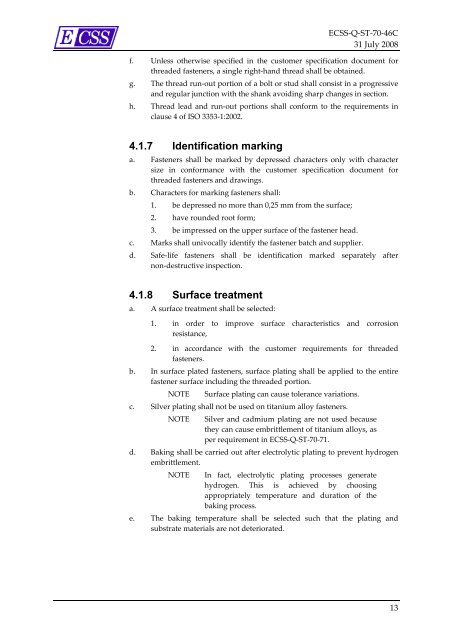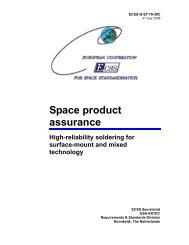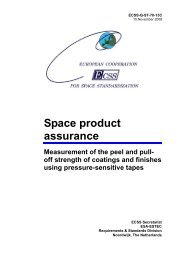ECSS-Q-ST-70-46C
ECSS-Q-ST-70-46C
ECSS-Q-ST-70-46C
You also want an ePaper? Increase the reach of your titles
YUMPU automatically turns print PDFs into web optimized ePapers that Google loves.
<strong>ECSS</strong>‐Q‐<strong>ST</strong>‐<strong>70</strong>‐<strong>46C</strong><br />
31 July 2008<br />
f. Unless otherwise specified in the customer specification document for<br />
threaded fasteners, a single right‐hand thread shall be obtained.<br />
g. The thread run‐out portion of a bolt or stud shall consist in a progressive<br />
and regular junction with the shank avoiding sharp changes in section.<br />
h. Thread lead and run‐out portions shall conform to the requirements in<br />
clause 4 of ISO 3353‐1:2002.<br />
4.1.7 Identification marking<br />
a. Fasteners shall be marked by depressed characters only with character<br />
size in conformance with the customer specification document for<br />
threaded fasteners and drawings.<br />
b. Characters for marking fasteners shall:<br />
1. be depressed no more than 0,25 mm from the surface;<br />
2. have rounded root form;<br />
3. be impressed on the upper surface of the fastener head.<br />
c. Marks shall univocally identify the fastener batch and supplier.<br />
d. Safe‐life fasteners shall be identification marked separately after<br />
non‐destructive inspection.<br />
4.1.8 Surface treatment<br />
a. A surface treatment shall be selected:<br />
1. in order to improve surface characteristics and corrosion<br />
resistance,<br />
2. in accordance with the customer requirements for threaded<br />
fasteners.<br />
b. In surface plated fasteners, surface plating shall be applied to the entire<br />
fastener surface including the threaded portion.<br />
NOTE Surface plating can cause tolerance variations.<br />
c. Silver plating shall not be used on titanium alloy fasteners.<br />
NOTE Silver and cadmium plating are not used because<br />
they can cause embrittlement of titanium alloys, as<br />
per requirement in <strong>ECSS</strong>‐Q‐<strong>ST</strong>‐<strong>70</strong>‐71.<br />
d. Baking shall be carried out after electrolytic plating to prevent hydrogen<br />
embrittlement.<br />
NOTE In fact, electrolytic plating processes generate<br />
hydrogen. This is achieved by choosing<br />
appropriately temperature and duration of the<br />
baking process.<br />
e. The baking temperature shall be selected such that the plating and<br />
substrate materials are not deteriorated.<br />
13
















